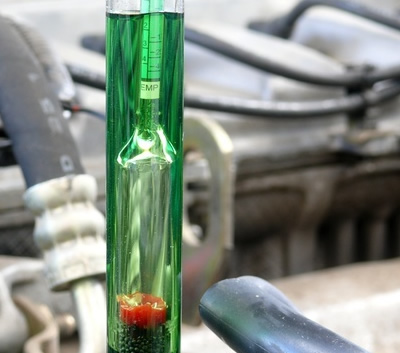The Glycol Recycling Process, Past and Present
February 5, 2014
Much of the business potential of glycol recycling lies in one fact: waste antifreeze is the only type of glycol being recycled in significant volume (more about that later in this post). So, process descriptions are limited to antifreeze and airplane de-icer recycling.
During use, glycols become contaminated and lose the properties that make antifreeze antifreeze. Recycling decontaminates waste antifreeze and makes it useful and compliant with environmental regulations again.
Descriptions of glycol recycling are usually limited to the chemicals and processes needed to treat used glycols. Using the triple bottom line method gives a very different picture of all the resources required to recycle glycol. Process steps, logistics and choice of technology all have roles in determining how sustainable and cost-effective the process might be.
 |
Antifreeze Recycling Options
|
Antifreeze Recycling Step by Step
Details of antifreeze recycling vary from one company to another. Although most process descriptions have three steps, we’ll add a fourth step. Individuals and companies that recycle antifreeze have several disposal options. We’ll concentrate on offsite recycling, the option that most people take.
STEP #1: Onsite collection and transportation
Triple bottom line accounting prompts us to pay attention to the real beginning of the antifreeze process, what happens at the antifreeze user’s site.
In offsite recycling, many gallons of waste antifreeze are collected and transferred onto tanker trucks. These trucks travel up to reach regional antifreeze recycling facilities. Since moving waste antifreeze incurs a significant part of total recycling costs, antifreeze recycling is usually done on a regional basis.
STEP #2: Treatment
For decades, physical separation was the only way to filter out reusable glycols from waste antifreeze. Now, chemical treatment and a hybrid method that combines chemical treatment and physical separation are also used commercially. Carefully applied, some of these methods effectively clean waste antifreeze for reuse as antifreeze.
Physical separation
Filter spent antifreeze for oil, which is separated and disposed of. Next, physical separation processes such as standard filtration or centrifugal separation and filtration can remove large particulate but not dissolved salts. Desalting technologies such as membrane separation, ion exchange, distillation, or combinations of these techniques must be used to remove all of the dissolved solids from the used antifreeze.
Treatment
Waste antifreeze is transferred to large vats containing several types of chemicals that help purify the used antifreeze. Flocculants help remove sediments from liquid antifreeze. Coagulants turn some dissolved chemicals into solids. Activated carbon, metal reducers and diatomaceous earth are added to the reactor to attract heavy metals and other contaminants, change their chemistry and convert metal molecules from their dissolved form into solids that can be separated and disposed of.
STEP #3: Formulating Antifreeze
Making the recycled material into usable antifreeze requires special additives, anti-corrosion agents, and dyes to be put back into the antifreeze formula.
STEP #4: Waste disposal
Depending on the type of recycling performed, wastes may include filters, sludge or resins. Proper disposal requires obtaining data about or testing the waste to determine whether it is hazardous. Whether you dispose of wastes or engage a mobilerecycling service to dispose them for you, these determination and disposal steps incur costs. (More about that in a later post.)
Next Time: We get down to business, discussing what makes antifreeze recycling profitable and sustainable.
The future can be cleaner.
At GlyEco, we believe providing information about chemistry-based pollution solutions is good for both the environment and your mind. Our team is dedicated to creating a future with less dirty glycol going to waste. It's a big job... and we are up to the challenge. Using our breakthrough technology, we clean all types of waste glycol, help safeguard the environment and create valuable green products.








